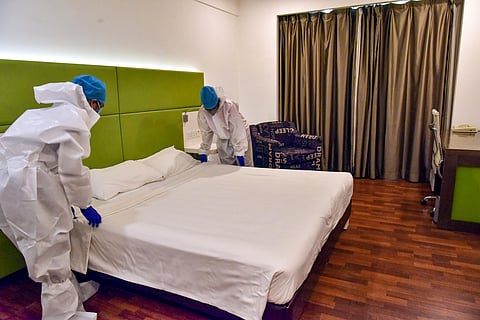

NEW DELHI: With increasing evidence of airborne route of transmission of SARS-CoV-2 and more threat in indoor spaces, the Centre has issued new guidelines recommending doubling of ventilation rate in indoor spaces in present coronavirus scenario.
The Council for Scientific and Industrial (CSIR) issues guidelines on Ventilation of Residential and Office for SARS-CoV-2 virus by modifying existing National Building Code, 2016, prescribing Air Changes per Hour (ACH) values in indoor spaces looking into the minimum recommended ventilation rates of 10 liters per second per person for the coronavirus.
The guidelines have been proposed for both naturally ventilated residential and office buildings, and mechanically ventilated residential and office buildings based on the scientific knowledge and engineering expertise available with the CSIR.
“When contaminants are to be removed from air, the amount of fresh air required to dilute indoor air depends on the air space available per person and the degree of physical activity. The amount of air decreases as the air space available per person per person increases, and it may vary from 20 cubic meter to 30 cubic meter per person per hour. This would be a business as usual scenario without considerations for airborne transmission of pathogens,” said the new guidelines.
However, in Covid-19 like situations, 36 cubic meter per person is recommended. Looking into the minimum recommended ventilation rates of 10 litres per person per second for the coronavirus like situations, the ventilation rates mentioned in the National Building Code have been modified.
“It is recommended that in a heavy smoke zone area and if the room is below the ground, the ventilation rates as specified by NBC are to be increased by 50 per cent. Even as the debate on the extent of contribution of airborne mode of transmission of Covid-19 continues, this route is now considered to be important by WHO and health authorities in several countries,” it added.
The guidelines mention that during breathing, singing, talking, forces are generated due to rapid shearing flows, vocal cord movement, opening and closing of terminal airways. As a result, droplets of different sizes loaded with viruses are generated and expelled, especially by asymptomatic and pre-symptomatic infected people.
“Results of different studies reveal that under typical indoor settings, the short range exposure occurs up to 1.5 meter distance between infected and exposed person while long range happens above 1.5-3 meter distance. The risk for the short range exposure is much higher that for the long range exposure,” it said.
The most effective manner of reducing the effects on any contaminant is by dilution with fresh air. Thus, ventilation is recognized as an efficient method for reducing the airborne transmission of pathogens. Therefore, there is a need for a paradigm shift in ventilation from space focused design to occupant focused design.